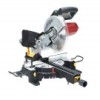Harbor Freight Tools 98199 User Manual - Page 12
General Operating Instructions, Making a Cut
 |
View all Harbor Freight Tools 98199 manuals
Add to My Manuals
Save this manual to your list of manuals |
Page 12 highlights
SAFETy SETUP General Operating Instructions 1. When the Handle is lowered, the Blade Guard 6. raises automatically. When the Handle is raised the Blade Guard returns to its safety position. Keep hands clear of the Blade when the Handle is lowered. Never interfere with the proper movement of the Blade Guard. 2. There are locking mechanisms for the miter angle and the Slides. Unlock the Table to set the miter angle, then re-lock it before 7. making the cut. Unlock the Slide using the Slide Lock Wing Screw before making a cut if the work material is too wide to "chop". 3. To rotate the Table, press down the Miter Thumb 8. Lever, rotate the Table to the desired angle, then release the Miter Lock Lever. Notches are machined into the Base of the tool which will lock the Table into several often used miter angles. These angles are 0º (centered), 15º, 22.5º, 30º and 45º both left and right cut. 9. 4. On wider pieces, you will have to slide the blade while making the cut. To unlock the Slide, loosen the Slide Lock Wing Screw at the back of the saw. 5. To make a bevel cut, release the Bevel Lock Lever, rotate the blade assembly to the desired bevel angle, then lock the blade assembly in place using the Bevel Lock Lever. Making bevel cuts is discussed in more detail later in this manual. Making a Cut 1. Observe all safety and planning items 6. discussed in this booklet. Detailed instructions on each of the following steps are discussed in this booklet. Do not make any cuts until you have read this entire booklet and are familiar with the operation of this tool. 7. 2. Release the Locking Pin to allow the blade assembly to come up. Check to be sure the 8. Table is fixed in place at the desired miter angle. Check to be sure the slide lock is released to allow the blade assembly to slide freely. 3. Blow any sawdust or debris away from the Fence. Place the work material against the Fence. 4. Make any necessary miter or bevel adjustments. 9. 5. Align the marked location of the cut on the work material with the saw blade. Be aware that the Saw Blade will remove material from the cut equal to the width of the blade. This is the "kerf". To prevent your work piece from being cut too short, align the edge of the blade with your measured mark, keeping the kerf on the waste side of the cut. This saw is provided with a Kerf Board. The Kerf Board helps to prevent tear-out on the bottom side of the work material. The Kerf Board is factory adjusted prior to shipment of this tool so the blade does not contact the Kerf Board during normal operation, including bevel cuts. Adjustment of the Kerf Board and techniques to prevent tear-out are discussed later in this booklet. Before starting work, check the accuracy of the Guide Fence, miter angle and bevel angle. Instructions for checking and adjusting these angles are discussed later in this booklet. It is very important that the work material be properly supported before making a cut. The material must be level on the Table. The material must be supported on both ends. Using the Work Piece Extension Supports is discussed in the next section. Use this saw only for its intended purpose of cutting flat rectangular or round wood stock, or finished molding. Do not use it for cutting firewood, brush, or anything that does not lie flat on the table. Doing so may cause binding or violent kick-back that may result in damage or personal injury. Hold the work material in place using the Hold Down Vise. Ensure that the work material is level and supported securely, using saw horses or supports if necessary. Grip the Saw Handle and squeeze the Trigger to start the Blade turning. Pressing down lightly, move the Blade smoothly across the work material to cut it. With narrow material, you can press straight down "chopping" the material. With wider material you must move the Blade across the material to cut it. Do not bear down on the material, use light downward pressure. If the material binds the blade, release the trigger. Keep your hands away from the Blade. When the cut is completed, raise the blade assembly, wait for the Blade to stop turning, release the Hold Down Vise and remove the work material from the saw. OPERATION MAINTENANCE Page 12 For technical questions, please call 1-888-866-5797. ITEM 98199















